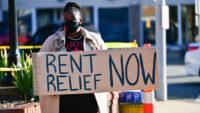As Israel’s military campaign in Gaza reached its eighth month in May, the United Nations released a report detailing the unprecedented scope of the coastal enclave’s destruction. Since the beginning of the ongoing conflict, the UN estimates that 370,000 housing units have been damaged, including 79,000 which have been destroyed completely, accounting for more than 70 percent of Gaza’s total housing stock. “We haven’t seen anything like this…since the Second World War,” UN Development Programme (UNDP) administrator Achim Steiner told the Associated Press. “That intensity in such a short time, and the massive scale.”
While demands for a ceasefire remain unanswered and bombs continue to fall, humanitarian organizations, alongside architects and engineers, are putting together tentative plans for Gaza’s recovery, an already daunting endeavor that will be made more complicated by political conditions on the ground.
Israel began its bombardment on Gaza after the Hamas terrorist attack on October 7, 2023, which killed at least 1,139 Israeli civilians and military personnel. In the first 89 days of conflict alone, Israel dropped an estimated 45,000 bombs on the narrow coastal strip. At 25 miles long by 7 miles wide, and with a population of 2 million, Gaza has a population density of 14,000 people per square mile (equivalent to London). In its urban cores like Gaza City, which has endured the brunt of the attacks, population density is three times greater. According to the UN’s most recent numbers, over 35,000 Palestinians have been killed, and at least 10,000 people are missing, lost among the over 37 million tons of rubble that now fill the streets of Gazan cities.

A house in the city of Rafah after an October 12 air strike. Photo © Anas Mohammed, via Shutterstock
“1.2 million Palestinians in Gaza have permanently lost their homes,” says Dr. Kit Miyamoto, founder and CEO of Miyamoto International (MI), a global engineering firm specializing in disaster recovery, both natural and man-made. In late April, MI released a report assessing Gaza’s structural damage, and outlining a tentative recovery plan. Informed by the firm’s current work in Ukraine, Miyamoto argues that providing rapid repairs to moderately damaged structures, which make up about 50 percent of Gaza’s total destroyed and damaged housing, can address immediate shelter needs within six months. Miyamoto, who was trained as a structural engineer and began his career in earthquake recovery, also noted that Gaza is extremely susceptible to earthquakes, with a risk on par with California, and that rebuilding for earthquake resilience would also guard against future airstrikes. “In earthquake conditions, we create very redundant structures where failure of one element doesn't cause total collapse—this is naturally adapted to blast forces as well,” he said.
Palestinian architect Salem Al Qudwa, an expert in Gazan residential reconstruction who is currently based in the United States, joined MI in April to organize and lead an on-the-ground team of engineers for the firm’s future reconstruction efforts in the enclave. However, of course, conditions will have to stabilize before work can begin. “If a ceasefire happened now, we're already on the ground with our local team and could start repairing housing really quickly,” says Miyamoto.
Rebuilding in Gaza after previous conflicts has been historically difficult. Since the Israeli-Egyptian blockade, imposed in 2007, Israel prevents the import of over 1,000 construction materials and equipment, including concrete, steel, and iron, which it considers can be used for military as well as civilian purposes. As a result, Palestinians have had to be resourceful—after an eleven-day offensive in 2021, which killed 256 Palestinians, Gazan architects and engineers used recycled rubble in reconstruction efforts. “[We have] to build on the creative initiatives that the local residents have already been doing, ” said London-based Palestinian architect Yara Sharif, co-founder of the group Architects for Gaza, in an NPR interview earlier this year. “They've already tested out a lot of materials that are sustainable and more responsive to the climate and to daily practices, but also to the difficulties of the siege.” Miyamoto says looking to the area’s traditional building techniques, which employ mud, clay, and stone, will be key for rebuilding quickly, and with limited resources. “Gaza has a great capacity for engineering,” he says, “Not only in modern construction, but also these ancient clay techniques that have disappeared in the last 20 years. Combining those could lead to really good sustainable solutions.”
However, according to the recent UN report, housing was rebuilt at a rate of only 992 units a year after previous conflicts. Even if Israel allows a five-fold increase of construction material to enter Gaza, it would cost $40 billion—over an optimistic timeline of 16 years—just to rebuild the destroyed housing units, without repairing the damaged ones. Beyond housing, the UN estimates that over 60 percent of Gaza’s total built environment has been damaged or destroyed, including the majority of schools, hospitals, and commercial facilities, and over a hundred heritage sites.

The Al-Farouk mosque in Rafah, as well as the surrounding residential area, was destroyed after an bombardment in February 2024. Photo © Anas Mohammed, via Shutterstock
External participants, focused on both short- and long-term recovery, agree that sustainable rebuilding is dependent on following the lead of the community. “The most important thing is to engage the people in Gaza as much as possible,” says Miyamoto. “They've been doing this for a long time and have a lot of expertise.” Abdallah Al Dardari, UNDP’s regional director for Arab states, told the AP that the organization’s early recovery framework will be “Palestinian-centered, Palestinian-led, and owned by the Palestinian people.”
Though parties are inching closer to a ceasefire agreement, these dreams of a Palestinian-led recovery are endangered by Israel’s competing political and economic interests. The office of Israeli Prime Minister Benjamin Netanyahu recently published a presentation called ‘Gaza 2035,' a glossy three-step redevelopment masterplan, replete with futuristic AI-generated skyscrapers, that neatly sidesteps the question of Palestinian statehood. A truly rebuilt Gaza will require more than concrete and steel—also the international support and political will to ensure the rights and self-determination of the Palestinian people throughout the reconstruction process.





